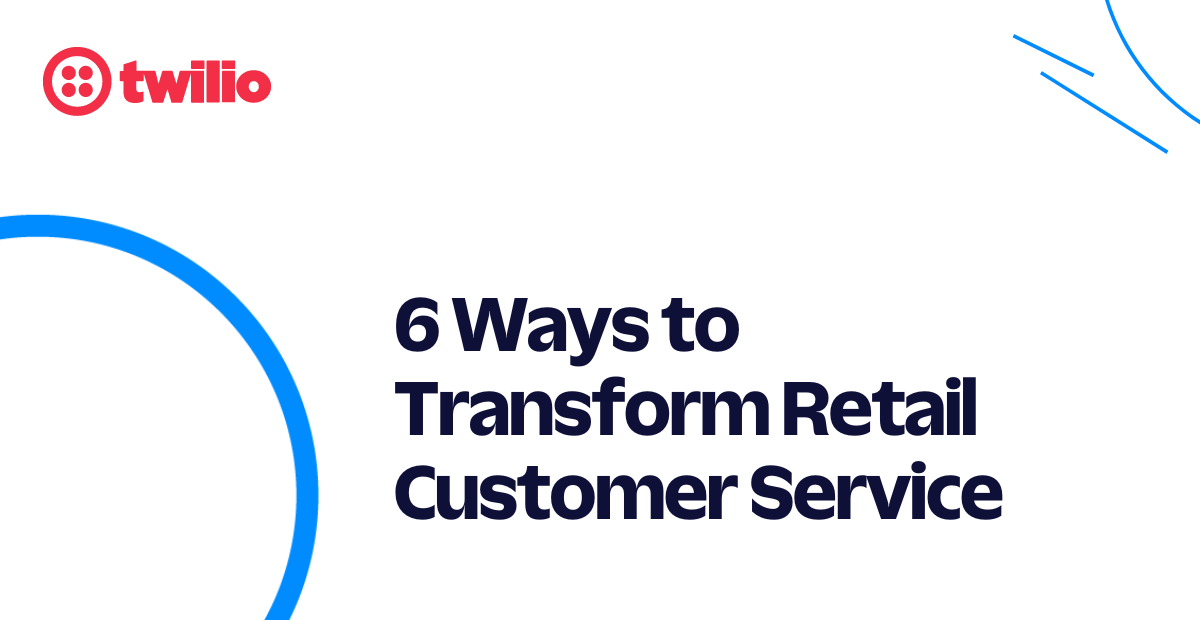6 Ways to Transform Retail Customer Service
Time to read: 5 minutes

Quality customer service is one of the pillars of customer-centric industries like retail. It increases brand loyalty and revenue, while poor customer service turns customers away. Need some proof?
- 56% of consumers claim they’ll discontinue business with a company after a frustrating customer service experience
- 59% of customers claim they’ll pay more for great customer experiences
It’s vital to create a positive experience on every channel, including in store and digitally. But disconnected channels and a lack of customer data can sometimes get in the way.
We’re here to help. This post will cover 6 ways to improve customer service in retail (and boost customer retention while you’re at it).
1. Unify customer data
Great customer service begins with great data. The more you know about your customers, the more efficiently you can serve them—without asking endless questions to understand their issue.
Customer data goes far beyond the individual’s contact information and shipping address. Every action they take on your channels and interaction with your business gives you valuable information to understand customers’ needs better.
But with data scattered across disconnected databases and platforms, it becomes challenging to unify it and create a full view of the customer. Enter customer data platforms (CDPs).
A CDP helps you gather and unify customer data to create complete profiles of a customer’s preferences and behaviors. Then, you can activate this data to personalize every interaction, improving customer retention and boosting your bottom line:
- 66% of consumers admit they’ll stop using a brand due to impersonalized experiences
- 57% of consumers report they’ll spend more on a brand with personalized experiences
The final piece of the data puzzle is giving your customer service agents access to real-time customer data from a single dashboard. So choose a CDP that integrates with your contact center and allows the seamless flow of data, equipping agents with the necessary information to provide personalized service.
2. Protect customer data
With great data comes great responsibility.
Data protection is nonnegotiable for customers: 98% of them say they want businesses to do more to guarantee their data privacy and be transparent about data usage. This starts with following customer data regulations like the General Data Protection Regulation and the California Consumer Privacy Act.
Next, consider the source of your customer data. As third-party cookies go away, businesses will rely on first-party and zero-party data to personalize customer experiences. Luckily, this type of data helps generate trust because customers provide it directly.
But to maintain that trust, it’s vital for businesses to protect customer data with secure authentication methods and give customers control over what data you store and use. After all, 95% of consumers report wanting more control over their data.
3. Invest in digital channels
Some people prefer in-store retail experiences over ecommerce. But when it comes to customer service, digital channels win. And businesses that meet customers where they prefer to communicate see results: 60% of brands claim that investing in digital customer engagement allowed them to meet changing customer needs.
Additionally, having an omnichannel presence for retail on live chat, SMS, and social media, drives revenue—businesses report that investing in digital engagement increased revenue by 90% on average in 2023. Lastly, an omnichannel contact center can help you improve customer retention.
It’s clear why businesses should invest in digital channels, so the next question is how to do so. With the right contact center platform, businesses can augment existing solutions and add integrate new channels. Plus, cloud-based platforms give customer service agents access to all channels from one dashboard, helping them serve customers more efficiently.
4. Predict customers’ needs
You don’t need a crystal ball to predict your customers’ needs. When you have the right tools—like a CDP, an integrated contact center platform, and AI—you can see where each customer is in the customer journey and predict what they’ll need from your business next.
For example, a CDP that tracks customers’ actions on your website can flag users who browse your website a few times without adding anything to their cart. This could mean they can’t find what they want or have questions. So you can build automation that triggers a chatbot offering assistance after a certain browsing period.
You can also employ proactive customer service to lighten the load for agents. For example, say many of your new customers contact your business’ live chat after their first purchase with questions about how to use the product. So you aggregate the most common questions and create a welcome email with a video tutorial on how to get started. This can reduce the number of customers reaching out via live chat while showing the customer you care about their experience.
5. Level up self-service
It may seem counterintuitive, but many customers prefer not to call customer service—36% of consumers admit they’d rather lose their internet connection for a day, go through airport security, or shave their head than contact customer service.
So help these customers help themselves with comprehensive self-service options like:
- Processing returns and exchanges on your website or app
- Tracking their order status via text message
- Chatting with virtual agents that help customers find FAQ pages or educational resources
- Self-routing through interactive voice response that helps customers find answers or take action without speaking to an agent
Offering self-service also helps keep customer service queues short, benefiting customers who prefer to pick up the phone. Plus, it means fewer calls or live chats for agents, enabling them to dedicate more time to customers with complex questions or issues.
6. Celebrate your customers
You know that warm-and-fuzzy feeling when the restaurant staff finds out it’s your birthday and brings you a free slice of cake? That’s great customer service at work. And this type of experience shows your customers how much you value them.
Customer service isn’t just about reactively responding to customers' questions and concerns, either. It’s also about creating experiences that delight customers and keep them coming back.
A great way to do this is celebrating your customers and showing your appreciation. For example, send the customer a free gift on their birthday or celebrate their anniversary of being a customer with bonus reward points. These tactics help improve customer retention, which, in turn, can reduce the need to spend more on customer acquisition.
Provide stellar retail customer service with Twilio Flex
Many of the retail customer service strategies in this post require certain tools to unify your customer data and engage customers across channels. But that doesn’t mean you must replace all your current systems.
With Twilio Flex, you can build the digital engagement center your business needs without a major overhaul of your systems. A Flex contact center enables you to:
- Add new digital channels that integrate with your existing systems.
- Integrate your contact center with your CDP.
- Create a single dashboard where customer service agents can access customer data, view the context of previous interactions, and engage customers across channels.
- Adapt any aspect of your contact center as your needs evolve.
Want to see how other businesses found the perfect contact center recipe? Read Cook Up a High-Impact Digital Engagement Center With Twilio Flex.
Related Posts
Related Resources
Twilio Docs
From APIs to SDKs to sample apps
API reference documentation, SDKs, helper libraries, quickstarts, and tutorials for your language and platform.
Resource Center
The latest ebooks, industry reports, and webinars
Learn from customer engagement experts to improve your own communication.
Ahoy
Twilio's developer community hub
Best practices, code samples, and inspiration to build communications and digital engagement experiences.


